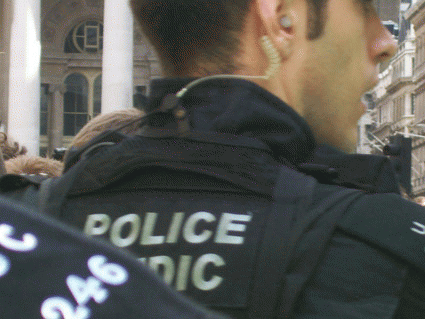Location Reporters: Patrick Henningsen and Brian Viziondanz
Authors’ Note: There were approximately 4,000 peaceful protesters at the City's second main demonstration area at Bishopsgate dubbed the "Climate Camp" Wednesday afternoon. This was a relatively mild affair compared to the larger and more pressurized gathering outside the Bank of England.
From the morning onwards, Climate Camp was clearly a festival atmosphere complete with live music, food, street theatre and dozens of small camping tents erected on the road in front the European Climate Exchange building on Bishopsgate. Activities included seminars being held to highlight some of the problems with Carbon Trading.
See video footage of the Climate Camp festivities here.
From approximately 5pm, hundreds of auxiliary police in riot gear began to seal the entire encampment, including all entrances and exits along this city block. Any peaceful protester who requested exit from the area were flatly refused on the grounds which police repeatedly told people including, "It is not safe to leave the area", and "We do not want people to leave and go on to join the other demonstration sites" and "We cannot risk you leaving the area and then throwing projectiles from behind our police lines."
What ensued after 7pm can only be described as a total 'Lock Down' of the public, after which protesters were hounded by a series of random forward surges by riot police, including incursions deep into the gathering. Note that by this point in the evening police forces had successfully "penned-in" approximately 4,000 peace protesters from both sides of this city block in a tactic which has come to be known as "Kettling". This restriction of the public's movement was extended to all protestors including anyone under physical duress, children, elderly, members of the Press and even passers by who happened into the area. The thousands who crowded at the four corners of the exits were in effect, forced to stand waiting for more than 4 and a half hours.
This eventually caused frustration in the crowds and inevitable pushing into police lines, followed by police retaliating by pushing back into the crowds. A recipe for disaster. We witness such an incident at 11pm at the north end of Bishopsgate where pushing nearly triggered a full scale brawl, narrowly averted, as cooler head prevailed. At 11:30pm police finally allowed the public at the north end to exit one by one. Just prior to 12am, Police moved to clear the peaceful sit-in with a further series of symmetrical surges, where a number of people and innocent bystanders were injured, including some hospitalised for injuries from falls and police baton blows.
"Another protester recounts the way that police at the end forced them out without giving them time to get their tents or belongings, after holding them there for five hours. ‘It was all done in a mood of violence,’ she said. ‘It had been really peaceful all day, so I don't understand why it had to end like that.’"
Also, there are multiple reports of police getting climate campers and press with video cameras to delete images and tapes on the spot, or face threat of seizure. See a full analysis these incidents at UK Indy Media.
What these reporters experienced at the Climate Camp protest was those whose job it was to 'keep the peace' and ensure public safety, behaved in a totally opposite way- with police repeatedly instigating crowds, in effect stimulating a breach of the peace. Predictably, this created a climate in which public health and safety was indeed compromised- and in many cases, endangered. Similar operations were also used on crowds out in 2005 at the G8 Summit in Edinburgh. The question for the public remains why would police follow through with a technique that is shown time and time again to create an obvious pressure cooker? The results of this were in plain sight and are by now well documented in the mainstream media.
It would be a gross oversight for apologists to describe such crowd control tactics as the result of multiple instances of rogue police, or police under stress. These apparent crowd control tactics of "sealing in" the public were in fact consistent throughout the main demonstrations in the City that day, which would lead the casual observer to conclude that this show of force was clearly a predetermined police plan, with command and control-level orders executed on the day.
Police officials had apparently summoned Climate Camp organizers in the days ahead of the April 1st demonstrations, but judging by the results of the day, this dialogue was completely ineffectual. The fundamental question still remains: how can Police foster a healthy relationship between the public and the police, especially between young people (who are the majority of demonstrators) and the police?
Is this the shape of things to come, or can police and demonstrators coexist in public spaces without the pressure created by "Kettling" crowds? More importantly, are civil liberties still applicable in 2009? The public and rights advocates will be expecting answers to these important before the next big demonstration.





